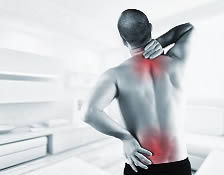Description

Earn credits through articles you've already read in our Massage Professionals Update e-newsletter.
In a recent survey, more than half of American's that had a massage said that they did so to relieve pain. Combining four articles written especially for the Institute's Massage Professionals Update E-newsletter, this brief program will provide insights into:
- The categories of chronic pain and how lifestyle impacts its development.
- The definition of complex regional pain syndrome and how massage therapy may reduce symptoms.
- Two natural topical pain relievers and the protocol for use in massage therapy.
- How a massage practitioner can influence a client's perception of pain.
In the Chronic Pain & Massage - What You Should Know program we've combined four articles written especially for the Institute's Massage Professionals Update. These four articles include:
- What Massage Therapists Should Know About Chronic Pain - Unhealthy lifestyle habits are known to contribute to the development of cancer or cardiovascular disease, but few people know that they can also foster chronic pain.
- Complex Regional Pain Syndrome and Massage Therapy - Chronic pain is a complaint massage therapists hear from many clients. The causes vary from pain as a result of injury or accident to post-surgery pain. There may be times that the actual cause is unknown or elusive. Learn more about complex regional pain syndrome, a chronic and often debilitating form of pain that may be helped by the use of massage therapy.
- 2 Natural Topical Pain Relievers - Chronic muscular pain is the number one complaint encountered by bodyworkers. Learn what two natural substances are considered to be superior pain-relievers by both the Western and complementary medical communities.
- A Practitioner's Influence on Client's Pain - With so many consumers living with chronic pain, massage therapists astutely study and practice techniques aimed toward pain relief. However, the most potent tool for helping a client overcome their pain resides in the therapist's head - not in their hands.
You can either read the articles by clicking on any of the titles above or upon enrollment you'll be able to access these articles and your online test through your online course account.
Course Reviews
Lorraine Moore, CMT
Great information. I practice chronic pain relief therapeutic massage in my practice and this course has not only been beneficial to me, but will also be especially beneficial to/for my clients. Thanks! L. Moore, CMT
Evelyn Clarke, LMT
This course validates what I've been doing all along. Thank you for the refresher and the info and facts that makes massage so interesting and beneficial.
Susan Morgan, LMT, NCTMB
Very informative and I learned new information for approaching pain relief facilitation with my clients. Thank you!
Jennifer N., LMT
This course is great, I love that I can print the material and go back to it as a refresher when i need it. This course met my expectations and this site is very user friendly, making life a lot easier for me when im taking these courses at home with 2 children. I will be recommending this site to my students on Monday!
Denise Petrey
This appropriate one-hour course regarding Chronic Pain was balanced between theory and practical knowledge.
Materials
- 4 MPU Original Articles - 11 pages
- Online multiple-choice test
- Certificate upon completion
Display Certificates suitable for framing are available for $10 in addition to the certificate included with your tuition. Click here to order a Display Certificate.
Approvals
The Institute is approved by the National Certification Board for Therapeutic Massage and Bodywork (NCBTMB) as a continuing education Approved Provider. Approved Provider 049478-00.
Credits also accepted by the AMTA, ABMP as well as most state boards.
For information regarding your specific state massage license requirements and approvals, visit our Massage Therapy Continuing Education Requirements page by clicking here.
 View larger
View larger